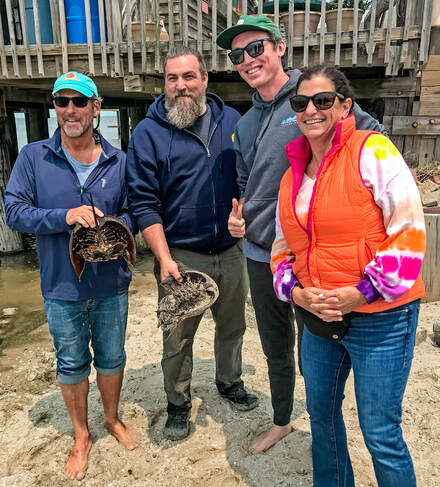|
Through a collaborative partnership with the Cape May Point Science Center (CMPSC) and Cellular Tracking Technologies (CTT), the American Littoral Society will be adding cellular tracking devices to our horseshoe crab tagging program. These tags will help us to remotely monitor and track the crabs as they come ashore and provide a better understanding on how often female crabs emerge, general horseshoe crab movement, and what informs their movement decisions. This new partnership kicked off on May 23 when staff from CMPSC and CTT, as well as donors Rob and Wendy Wilson, joined us for a special tagging event at Reeds Beach, along the Delaware Bay in southern New Jersey. These new PowerTags are in addition to those the Society has been using for years that provide some basic insight on crab movement when tagged crabs are recaptured.  Donors Rob and Wendy Wilson (left and right), join Littoral Society Habitat Restoration Project Manager Shane Godshall and Sean Burcher, Director of Scientific Operations for the Cape May Point Science Center, on Reeds Beach. Donors Rob and Wendy Wilson (left and right), join Littoral Society Habitat Restoration Project Manager Shane Godshall and Sean Burcher, Director of Scientific Operations for the Cape May Point Science Center, on Reeds Beach. The primary goal of the new tags is to unravel the mysteries surrounding female horseshoe crabs behavior, particularly their emergence on a beach and their movement patterns before spawning. By understanding what factors inform their decisions to move, we can gain valuable insights into their reproductive cycles and overall population dynamics. To gather this crucial data, tags which transmit radio telemetry data are glued to each crab's shell. After monitoring the crabs for an hour as the epoxy cures, they are released back into the water, ready to continue their journey. Whenever the crabs crawl ashore, their location is recorded. Preliminary data (visible in the tide chart below) has shown that the crabs tend to come ashore just after high tide events and that they can move to different beaches for spawning. One tagged crab moved 500 meters south to Cooks Beach, another of the beaches the Littoral Society restored following Hurricane Sandy. Each ping brings us closer to unraveling the secrets of their behavior and better understanding their crucial role in our coastal ecosystems. Stay tuned for more exciting updates as we continue this remarkable journey of exploration and understanding! 6/23/2023 07:30:46 am
I have noticed that females have two clutches of eggs in their bodies and have seen some females that only seem to spawn on the full moon tides while others only seem to spawn on the new moon high tides. It would seem that your tags might be able to prove or disprove my hunch. Could you keep an eye out for this? Any comments from what you have seen? Thanks!! Comments are closed.
|
Archives
July 2024
Categories
All
|


